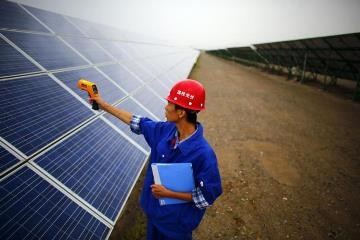China's photovoltaic (PV) industry has begun to pick up since last year, with a new aim to support the construction of solar power stations with installed capacity of 17.8 GW for this year, following serious sales slumps caused by the imposition of anti-dumping duties by the U.S. and the European Union, the Economic Information Daily reported.
The report said that the National Energy Administration (NEA) launched a three-year "pioneer" project to bolster the industry despite some unfavorable challenges to its development.
The paper said that some of the problems of the industry include high non-performing loan rates, inability to upgrade technologies, and intense competition from Malaysia, India and Europe in international markets, which led to speculations that foreign enterprises are interested to acquire some Chinese solar panel makers.
NEA statistics showed that in the first half of the year, China's installed PV or solar power generation capacity increased by 7.73 GW, more than two times the figure of 3.32 GW recorded the previous year. The data further showed that the turnout in the manufacturing end of the industry is also rapid, with the capacity utilization rate reaching over 85 percent or even more than 100 percent.
"We are facing increasingly intense competition from foreign countries, especially Malaysia and India, in terms of low-end production. India, for instance, is planning to sharply boost its production capacity for photovoltaic components to 100 GW by 2022 from an existing level of only 3GW," Wang Bohua, secretary-general of the China Photovoltaic Industry Association, was quoted as saying.
Wang said that the xGWp project being implemented by the European Union aims to establish a gigawatt-scale photovoltaic cell and module based on next-generation technologies.
"With this, we're facing severe and pressing challenges in whether we can maintain a leading position in the new round of competition in technology advancement," Wang added.
China has become one of the leading suppliers of photovoltaic products in the world, but the industrial structure needs more improvement, having an overcapacity for medium to low-end production and an insufficient capacity to produce high-end products, the report said.
According to an industry insider, the local photovoltaic products manufacturing equipment has hit 90 percent, and it would need a total of 34 billion yuan ($5.3 billion) to finance the upgrading of 20 GW capacity equipment. But enterprises in the sector cannot afford to support it, Wang said.
"China currently still enjoys remarkable technical advantages in the photovoltaic industry. But tight financial chains and heavy financial burdens have made us unable to invest more in R&D projects," Zhu Zhikuo, CEO of Trina Solar, a leading maker of solar cells and modules in China, was quoted as saying.
Photovoltaics companies have recorded an average non-performing loan rate at a high of 7 percent, far higher than the average NPL rate of 1 percent, as of the end of 2014, which discouraged banks from lending to solar enterprises.
To help enterprises in the photovoltaic industry and to counter the loan issues, the NEA launched a three-year pioneer project to help enterprises upgrade their technologies and product quality, as well as help with their efficiency and low-end production capacity, in addition to building their brands.



























